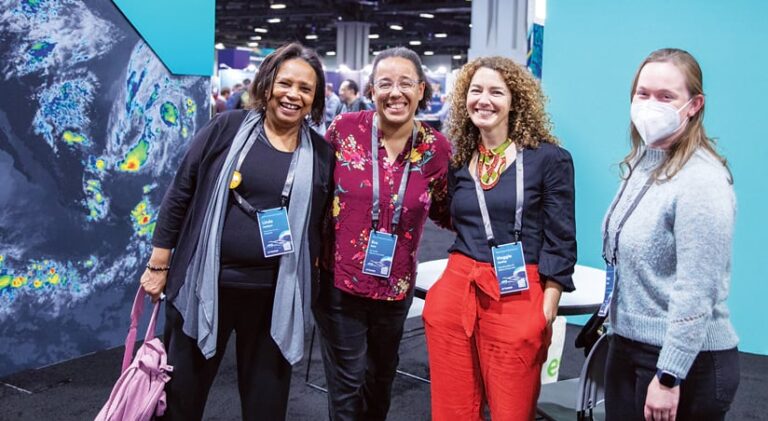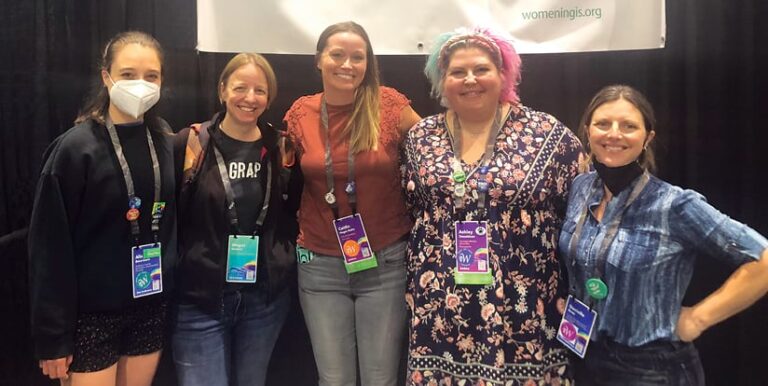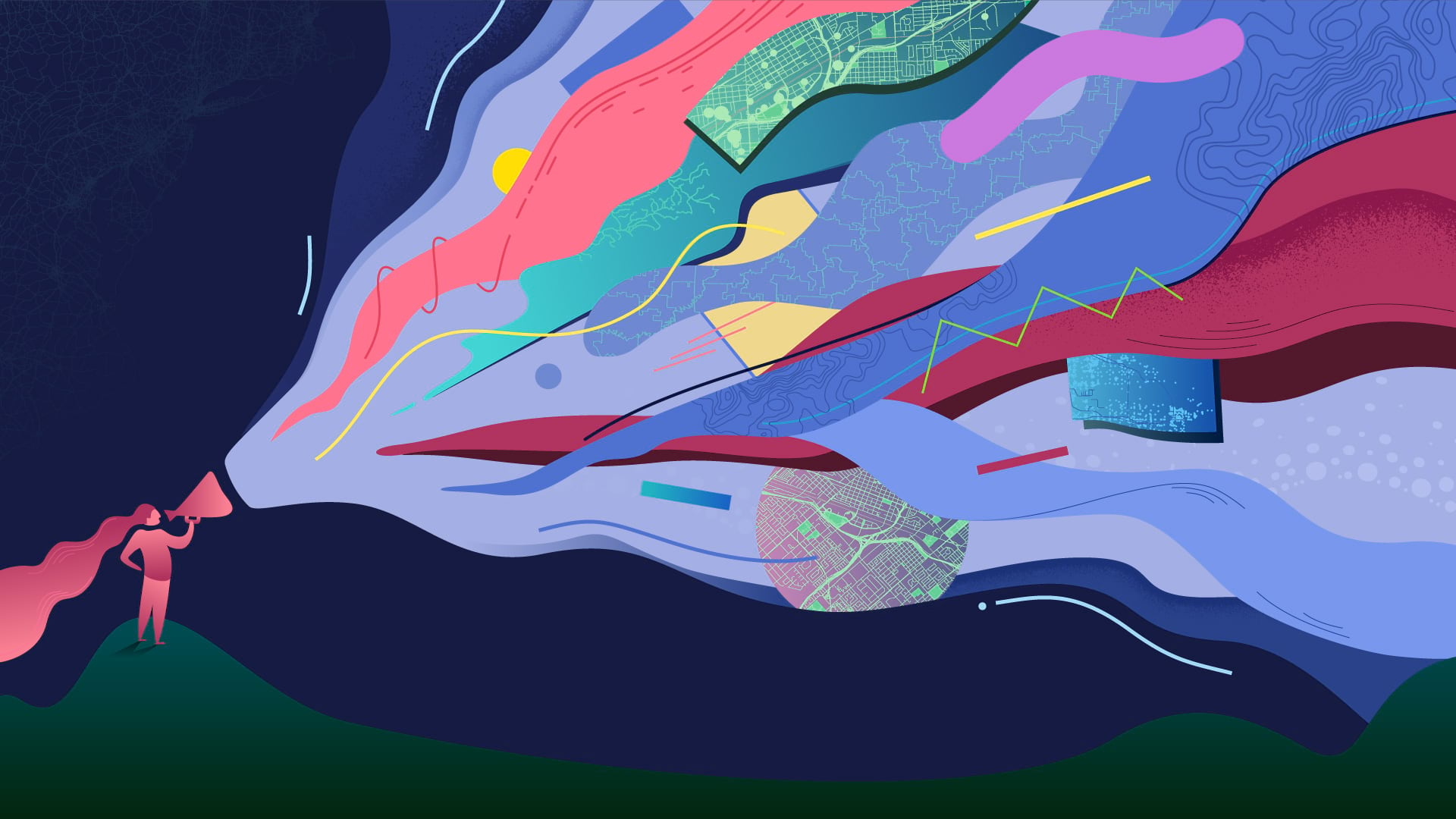When Danielle Bram got her start in GIS about 20 years ago, she felt a little isolated.
“Part of that was just because I was new to the field, but GIS was also very male dominated at the time,” recalled Bram, who is now the director of the Center for Geospatial Science and Technology at California State University, Northridge.
She remembers sitting alone at lunch at her first Esri User Conference (Esri UC), not knowing anyone and not knowing what to do about it.
“I even felt intimidated by some of the groups that hosted open meetings at the conference,” Bram said.

It’s one of the reasons she eventually cofounded Women in GIS, an international professional organization and social advocacy group for women and their allies that seeks to foster unity among women in GIS and anyone else who feels that they could benefit from a vibrant, active, and welcoming community. The organization serves as a safe place for women and others from all geospatial fields to work together to overcome common barriers, such as job discrimination, professional isolation, and lower pay. Through workshops, regular Communities of Practice meetings, formal and informal gatherings at conferences, and more, members of Women in GIS develop meaningful and lasting relationships and share valuable resources to help one another succeed.
“We create spaces where there’s no judgment and people feel comfortable talking,” said Eva Reid, senior IT data manager for DC Health, who also serves as chair for the Women in GIS Outreach Committee and leads the Washington, DC, chapter of the organization. “People can jump in with ideas, and nobody says, ‘You can’t do that.’ Instead, everyone says, ‘Oh, cool! Do you want to run with that project?’ Women in GIS is, in many ways, the best of what people hope to have in their workplaces.”
The Need to Support Women Working in GIS
The idea for Women in GIS came about at the 2015 California GIS Conference, known as CalGIS.
“A group of us met to talk about being women in geospatial fields, and we said, ‘Wouldn’t it be great if there was more of a forum and support for women in GIS?’” said Bram. “As far as we knew, there was nothing like that. So we said, ‘What if we just threw a website up and got people to connect by facilitating networking?’”
Bram and several others from that original CalGIS meetup started off small when they cofounded Women in GIS before realizing that the group could—and should—get more involved.
“Women in GIS just kept growing organically,” Bram said. “We wanted to develop opportunities for chapters to form, and we wanted to collect membership fees to be able to better support women. To do that, Women in GIS needed to become a nonprofit.”
The organization gained fiscal sponsorship from the Northern California chapter of the Urban and Regional Information Systems Association in 2017 and then secured critical funds from Esri. This enabled Women in GIS to become a 501(c)(6) organization in 2020, meaning donations can be written off as a business expense.
“We’ve been growing from there, developing our board and having more women get involved,” said Bram, who served as a past president of Women in GIS and is currently the chair of internal affairs. “It’s really exciting to see where we are now.”
“When Women in GIS was formed back in 2017, it met a tremendous need within the geospatial community, particularly in North America,” said Esri chief scientist Dawn Wright, who is a member of the organization. “Women in GIS has grown to be a strong and positive force for women.”
A Glocal Community That Keeps Growing
According to Caitlin Hagar-Kuhn, the current president of Women in GIS and a senior GIS consultant at Esri partner Locana, Women in GIS is a “glocal” community that has evolved both from the top down and from the grassroots up.
“We have the parent organization acting as the global virtual community, which really helps people who are experiencing professional isolation if they are, say, the only GIS person in their organization,” she said. “And then the local chapters also give members the opportunity to meet regularly in person. So both the affiliates and the chapters are huge contributors to the growth of the organization.”
While most Women in GIS members are based in the United States, it is a thriving international organization.

“We have members from around the world, and we want people from everywhere to get involved,” said Bram. “We understand that it can be challenging to do this in areas where these kinds of opportunities are sparse, so we are working on ways to facilitate that.”
“At the last Esri UC, we had quite a few folks come to our booth who wanted to start chapters in other countries,” Hagar-Kuhn added. “That was very exciting, and we hope to see more of that. With technology that makes it easier to translate to other languages and record presentations so people can watch them at convenient times in their own time zones, we’re exploring a lot of new options in the accessibility realm.”
Women in GIS is also open to people of all genders and those who work in GIS-adjacent fields.
“We’ve had men join because they want to donate funds and support women that they know in the field,” said Bram. “We had a geography professor join once because he wanted to figure out how to get memberships for a whole bunch of his female students.”
Reid, who has worked in GIS for 30 years but is now in more of an IT management role, has found Women in GIS to be welcoming and engaging even though she doesn’t work with GIS every day anymore.
“When I took my current job, I had a moment where I wondered if I belonged in the GIS field anymore,” she said. “Being a member of Women in GIS showed me that I do. I may not be doing mapping day-to-day anymore, but I still feel very welcome here. I think that that speaks to the value of the membership and what a great community this is.”
The Myriad Benefits of Being a Member
To get involved with Women in GIS, Hagar-Kuhn recommends visiting the organization’s website. There, visitors can find information about membership and sponsorship opportunities, listen to the new interview-style Geography without Borders podcast, and follow the organization’s social media accounts.
“Social media is probably the best way to find out about what’s going on,” said Hagar-Kuhn. “People can dip their toes in and see if they want to attend a workshop or become a member.”
Members of Women in GIS get discounts on workshops, including the quarterly professional development one; the ability to upload a résumé to the organization’s job board for free; and access to committees, mentoring, and monthly Communities of Practice meetings. Pricing is tiered, and for anyone who doesn’t have the means to pay out of pocket, Women in GIS offers a limited number of financial assistance opportunities. Because Women in GIS is volunteer based, all membership fees, sponsorships, and donations go back to the community to fund workshops, scholarships for undergraduate and graduate students, grants for professional development, and more.
The job board is a valuable resource for members and sponsors, who can all post job openings.
“Companies and organizations used to ask us to post job announcements for them because they wanted to hire more women,” said Bram. “Now we actually have a way to connect employers with people who are looking for jobs.”
Women in GIS also has a booth at three Esri conferences per year, including the Esri UC and the Esri Developer Summit.
“The number of women in the developer space of GIS is increasing so quickly, so I’m hoping we can reach a lot of people in that realm,” said Hagar-Kuhn.
Wright thinks they will, given that several of the organization’s meetings at conferences have been standing room only.
“The gatherings that Women in GIS holds at Esri conferences have been a boon for attendees and even Esri,” she said. “I have also found their Communities of Practice meetings, held over Zoom, to be extremely helpful.”
These meetups are organized by topic, such as infrastructure, natural resources, and the public and private sectors, and they are largely unstructured in order to give attendees the chance to speak their minds.
“I’ve had a number of people come up to me and say, ‘This has been a really great space to just have conversations about things that are happening in my job,’ or, ‘I’m looking for new opportunities, and these meetings are helping me figure out what’s next,’” said Reid.
Women in GIS lets members be as involved as they want to be.
“If you’d like to volunteer for a committee, that’s great! We could always use more hands on deck,” said Reid.
“That said, we are all very respectful of each other’s bandwidths,” Hagar-Kuhn added.
A Gratifying Experience
For Bram, Reid, and Hagar-Kuhn, it is fulfilling to witness so many women and their allies—who work in GIS or adjacent fields and hail from all over the world—get involved with and learn and grow through Women in GIS.
“I have seen people network through the organization and find their first big-hit job or internship or even meet a mentor who guides them through the early stages of their careers,” said Hagar-Kuhn.
“There is so much opportunity within this organization to learn and give,” said Reid.
“It’s really gratifying to be a part of it,” added Bram.

